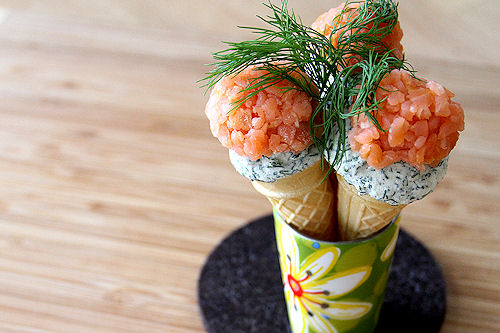
26 Apr ART-724 -Power of expectation food
Our experience of the sensory environment is determined not only by the physical characteristics of stimuli, but also by beliefs, prior knowledge, and expectations (Gibson, 1966, 1979; O’Regan & Noe, 2001; Rosch, Varela, & Thompson, 1991). Taste perception, in particular, is influenced by a variety of factors beyond primary sensory information. Characteristics such as color, texture, odor, price, and fat content have been shown to give rise to expectations that influence subsequent flavor evaluations (e.g., Cardello & MacFie, 2007; DuBose, Cardello, & Maller, 1980; Koch & Koch, 2003; Levitan, Zampini, Li, & Spence, 2008; Shankar, Levitan, Prescott, & Spence, 2009; Zampini, Wantling, Phillips, & Spence, 2008; Zellner & Durlach, 2003). The present investigation explores whether such expectations can directly affect primary taste processing, thus indicating a modulation of responses at a perceptual level.
Evidence is emerging that expectations can affect the neural processing of sensory stimuli. Generally, expected stimuli will evoke reduced brain activation compared with stimuli that are unexpected; for example, a reduction of activity in the fusiform area for expected face images (see Summerfield, Wyart, Mareike Johnen, & de Gardelle, 2011) in the auditory region for expected tones (Todorivic, van Ede, Maris, & de Lange, 2011) and reduced N400 EEG responses to expected visual (e.g., Bobes, Valdessosa, & Olivares, 1994; Proverbio & Riva, 2009), auditory (e.g., Besson & Faita, 1995; Painter & Koelsch, 2011), and olfactory (e.g., Castle, Toller, & Milligan, 2000; Kowalewski & Murphy, 2012) stimulation. However, this has been little explored in terms of gustatory stimuli.
Behaviorally, responses to taste are markedly susceptible to expectations, with studies showing that color can affect the identification of flavors (e.g., Du Bose et al., 1980), branding can promote flavor preference (e.g., McClure et al., 2004), and “healthy” labeling can reduce palatability ratings (e.g., Wardle & Solomons, 1994). It has been proposed that a central mechanism may underlie this effect, in that neural responses to a taste adapt to assimilate to the prior expectations (Braun‐LaTour & LaTour, 2005; Hoch & Ha, 1986; Lee, Frederick, & Ariely, 2006; Okamoto & Dan, 2013).
Despite a paucity of studies, there is some evidence that cortical responses to taste can be modulated by expectation (e.g., Grabenhorst, Rolls, & Bilderbeck, 2007; Nitschke et al., 2006; Plassmann, ODoherty, Shiv, & Rangel, 2008; Sarinopoulos, Dixon, Short, Davidson, & Nitschke, 2006; Woods et al., 2011). Nitschke et al. (2006) and Sarinopoulolos et al. (2006) found that when participants were presented with a cue that led them to believe that an upcoming bitter quinine taste would be less distasteful than it actually was, they reported it to be less aversive than when they received accurate information. Moreover, fMRI data showed that bitter taste activated the bilateral primary gustatory cortex (PGC) less strongly when preceded by a mildly aversive cue than by a highly aversive cue. No reliable changes in cortical activation as a function of pleasant taste or cue condition were detected, suggesting that the effects reported with quinine solutions reflect specific processing of aversive stimuli and a lack of generalization of the expectancy effect to other tastes. However, subjective ratings were obtained for pleasantness but not intensity, so it is possible that the expectancy effects were related to the perception of intensity and not directly to changes in pleasantness (Okamoto & Dan, 2013). Moreover, a study by Woods et al. (2011) has provided evidence of assimilation effects in relation to sweetness intensity. They found that a “very sweet” textual cue both enhanced subjective ratings of the intensity of a diluted orange juice drink and increased activations in the PGC. Interestingly, a complementary devaluation of ratings was not observed when an undiluted juice was preceded by a “less sweet” cue, and there was no alteration of cortical activation.
Expectations (belief or anticipation of future events) often determine whether or not we like a food. Positive or negative expectations often determine whether or not the individual chooses to consume the food. Therefore, people in the food industry often provide information or set up conditions in order to optimize the consumer’s experience and expectation of food. A large body of research shows that expectations affect food experiences (Wansink, 2004). Our taste and flavor likings are biased by our expectations and, in many circumstances, if you expect that you will like a food…you probably will. However, expectation also works in the opposite direction; expect a food to taste unpleasant and it probably will (Wansink, 2006).
Smoked Salmon Ice Cream

Yeomans and colleagues (2008) investigated how expectations influenced liking an unusual flavor of ice cream—smoked salmon ice cream. One group ate the ice cream from a dish labeled “ice cream” and another group ate the ice cream from a dish labeled “frozen savory mousse.” The experience of the food in the mouth generated strong dislike when labeled as ice cream, but it didn’t seem to be so bad when labeled as frozen savory mousse. Labeling the food as ice cream also resulted in stronger ratings of how salty the food was as opposed to when it was labeled as a savory food. The individuals that ate the frozen savory mousse found the ice cream less salty and bitter and found its overall flavor more pleasant.
California beats North Dakota
Forty-nine graduate students at a wine and cheese reception were presented with wine that had a label indicating that it was from either California or North Dakota. Those who believed their wine was from California liked the taste of both the wine and the cheeses better. In a second study, 39 patrons attending a prix–fixe dinner at a university–affiliated restaurant were given a glass of either North Dakota–labeled or California–labeled wine with their meal. The amount of leftover food and wine was measured. Individuals who received the California–labeled wine consumed 12% more of their entrée and consumed a greater weight of wine and entrée combined compared to those who were served North Dakota–labeled wine. The researchers concluded that not only does taste expectation influence one’s taste ratings of accompanying foods, but it also influences consumption of accompanying foods (Wanskink et al., 2007). Often when referring to taste, we really mean flavor (as demonstrated in the previous sentence). Flavor is determined by taste, smell, and chemosensory irritation. (Chemosensory irritation is detected by receptors in the skin throughout the head and, particularly in regards to food, receptors in the mouth and nose. An example is the burn of hot peppers and the cooling effect of menthol).
Expensive wines
Goldstein and colleagues (2008) investigated the relationship between price and subjective appreciation of wines when the price is unknown. A sample of more than 6,000 participants from 17 US blind taste tests were compiled and examined. Blind taste tests help eliminate confounds (potential flaws in the study) such as price and published expert ratings (both may contribute to expectations). The blind taste tests followed a double blind protocol in which neither the person serving the wine nor the person tasting the wine knew the type or price of the wine.
The tasters assigned an overall rating to the wine tasted prior to discussing the tasting with the rest of the group. The prices of the wines used in the taste tests ranged from $1.65 to $150 per bottle. The main finding after examining the blind taste tests was that individuals who are unaware of the price generally do not report higher ratings of more expensive wine. Actually, they enjoy more expensive wine a little less. However, in double blind taste tests, experts generally rate expensive wine higher than less expensive wine. The pleasure derived from consuming wine depends on taste and smell, but it also depends on price and presentation.
“Brain imaging research shows that as subjects sip what they believe is an expensive wine, brain areas associated with pleasure are more greatly activated than if they sip the same wine but are told it’s cheap” (Rosenblum, 2010, p.117).
Roasted Vegetable Crackers
In a recent experiment conducted at Eastern Kentucky University, researchers examined how expectations influence cracker ratings on a scale of likeability (Hale, 2012). However, participants were not aware that the primary interest of the study was how expectations influence cracker ratings. Participants were assigned to either a positive expectation group or a neutral expectation group. Participants in the positive expectation group received a positive verbal cue indicating that the crackers had recently been rated high in a national taste test. The neutral expectation group did not receive the information concerning the national taste test. Participants were then administered critical thinking tasks while consuming crackers. It was hypothesized that those in the positive expectation group would rate the crackers higher than those in the neutral expectation group. However, the results of the study did not support the hypothesis. There was no difference in how the groups rated the crackers.
The findings in the cracker study suggest that positive suggestions do not always lead to increased ratings of food. One possibility for explaining this finding is that participants in the positive expectation group actually did not have a positive expectation regarding the flavor of the crackers. Maybe the information about the taste test that was intended to induce a positive expectation did not work. Another possibility for explaining the outcome of the study is that the sensory properties of the food were inconsistent with the expectations. That is, participants in the positive expectation group expected the crackers to have a good flavor, but their expectations were disconfirmed when eating the crackers. The type of food used in this study may have placed limitations on the outcome. Positive expectations may be hard to induce for a neutral food such as crackers.
Future Directions
It is important to continue with studies that investigate expectations and their roles in food liking and eating behaviors. Research shows that expectations help to shape our perceptions of food in a variety of different contexts. However, expectations do not always influence food liking, as seen in the cracker experiment. It is important to point out that expectations play a role but definitely are not solely responsible for taste and flavor perception. Sensory stimuli (stimulating sensory receptors) also play a role in taste and flavor interpretations. Further research is needed to explore various avenues in which food expectations may be induced. The primary goals concerning food expectation research are finding new areas where expectations influence food perception and understanding how to use these findings to enhance nutrition quality.
References
- Goldstein, R., Almenberg, J., & Dreber, A. (2008). Do more expensive wines taste better? Evidence from a large sample of blind tastings. Economics and Finance, 700, 1-11.
- Hale, J. (2012). Expectations Do Not Always Influence Food Liking. Not yet published.
- Rosenblum, LD. (2010). See What I’m Saying: The Extraordinary Powers of Our Five Senses. New York, NY: Norton.
- Wansink, B. (2006). Mindless Eating: Why We Eat More Than We Think. New York, NY: Bantam
- Wansink, B. (2004). Environmental factors that increase the food intake and consumption volume of unknowing consumers. Annu. Rev. Nutr, 24, 455-479.
- Wansink, B., et al. (2007). Fine as North Dakota Wine: Sensory Expectations and the Intake of Companion Foods,” Physiology and Behavior, 90 (5), 712–16.
- Yeomans, MR., et al. (2008). The role of expectancy in sensory and hedonic evaluation. The case of


Sorry, the comment form is closed at this time.